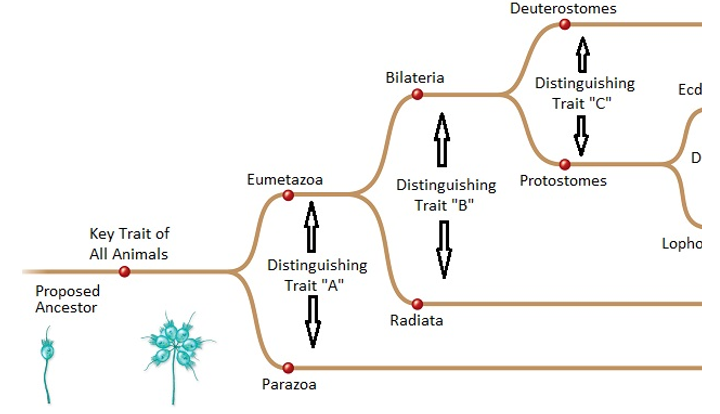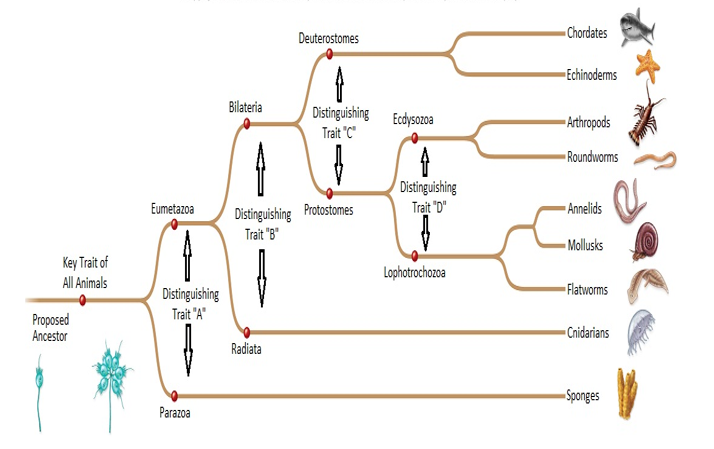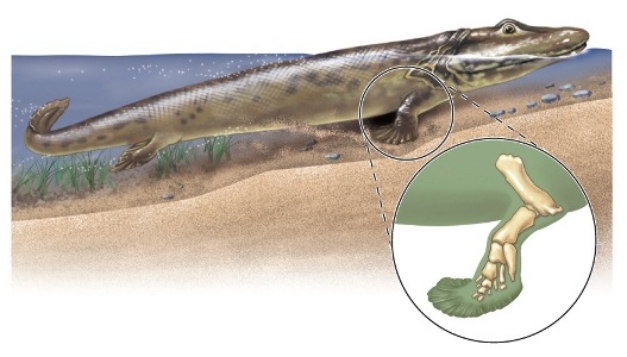A) mollusks
B) cnidarians
C) amphibians
D) arthropods
E) echinoderms
G) C) and D)
Correct Answer

verified
Correct Answer
verified
Multiple Choice
Figuer:
Main animal groups are noted at the right. Names diverging at each node are morphological or body form names. Note that the animal traits key to distinguishing the groups and body forms are not shown.  -The distinguishing animal trait "A," that separates the body forms of the Eumetazoa and the Parazoa is
-The distinguishing animal trait "A," that separates the body forms of the Eumetazoa and the Parazoa is
A) whether it is the mouth or the anus which forms first from the opening in the developing embryo.
B) whether or not the animal has true tissues.
C) whether the animal must periodically molt in order to grow, or has characteristic soft larval stages.
D) whether the animal has bilateral symmetry and three germ layers, or radial symmetry and two germ layers.
E) None of these answer options is correct.
G) D) and E)
Correct Answer

verified
Correct Answer
verified
Multiple Choice
Which of the following is not a characteristic of mammals?
A) They are endothermic.
B) They have a skeletal system composed of bone.
C) They have a two-chambered heart.
D) They have an amnion.
E) They have lungs.
G) B) and D)
Correct Answer

verified
Correct Answer
verified
Multiple Choice
Figuer:
Main animal groups are noted at the right. Names diverging at each node are morphological or body form names. Note that the animal traits key to distinguishing the groups and body forms are not shown.
 -The proposed common ancestor to all animals,shown at the left of the evolutionary tree,was a
-The proposed common ancestor to all animals,shown at the left of the evolutionary tree,was a
A) plant.
B) protist.
C) bacterium.
D) fungus.
E) None of these answer options is correct. A simplified animal was the proposed common ancestor.
G) A) and D)
Correct Answer

verified
Correct Answer
verified
Multiple Choice
Which of the following are characteristics of hagfishes?
A) They have a cranium.
B) They have a notocord composed of cartilage.
C) They have vertebrae.
D) They have a cranium and vertebrae.
E) They have a cranium and a notocord composed of cartilage.
G) A) and C)
Correct Answer

verified
Correct Answer
verified
True/False
Some animals are autotrophs.
B) False
Correct Answer

verified
Correct Answer
verified
Multiple Choice
In most species, the female frog lays her eggs directly in the water as a male clasps her back and releases sperm. The fertilized eggs hatch into legless, aquatic tadpoles. Most tadpoles feed on algae, and have gills. As they mature, tadpoles develop legs and lungs, lose the tail, and acquire carnivorous tastes. -Frogs have which of the following traits?
A) cartilaginous skeleton
B) larval respiration with gills, but adult respiration with lungs
C) jawless
D) incomplete digestive tract
E) endothermic
G) A) and C)
Correct Answer

verified
Correct Answer
verified
Multiple Choice
In a biology lab dissection,you find that an organism,called a lancelet,has a flexible rod of nerve cells,extending along its back to its tail.It is a member of the phylum
A) Echinoderms.
B) Arthropods.
C) Nematodes.
D) Chordates.
E) Cnidarians.
G) A) and E)
Correct Answer

verified
Correct Answer
verified
Multiple Choice
The most successful phylum in regards to diversity and numbers is
A) Platyhelminthes.
B) Mollusca.
C) Echinodermata.
D) Arthropoda.
E) Nematoda.
G) A) and D)
Correct Answer

verified
Correct Answer
verified
True/False
The tendency to concentrate sensory organs and brain at the head end of an animal is called cephalization.
B) False
Correct Answer

verified
Correct Answer
verified
Multiple Choice
Which of the following are characteristics of reptiles?
A) They have lungs.
B) They have lungs and a skeleton composed of cartilage.
C) They have a skeleton composed of cartilage.
D) They have lungs and are ectotherms.
E) They are ectotherms.
G) A) and E)
Correct Answer

verified
Correct Answer
verified
True/False
Centipedes,earthworms,and roundworms all illustrate segmentation.
B) False
Correct Answer

verified
Correct Answer
verified
Multiple Choice
In most species, the female frog lays her eggs directly in the water as a male clasps her back and releases sperm. The fertilized eggs hatch into legless, aquatic tadpoles. Most tadpoles feed on algae, and have gills. As they mature, tadpoles develop legs and lungs, lose the tail, and acquire carnivorous tastes. -The primary function of external gills in aquatic animals is to
A) transport blood.
B) secrete reproductive hormones.
C) relay nerve impulses.
D) exchange gases with the water.
E) defend against invading microorganisms.
G) A) and B)
Correct Answer

verified
Correct Answer
verified
Multiple Choice
Amphioxus is an example of a
A) hagfish.
B) amphibian.
C) tunicate.
D) lancelet.
E) reptile.
G) A) and E)
Correct Answer

verified
Correct Answer
verified
Multiple Choice
All of these animals are mollusks except
A) chitons.
B) terrestrial snails and slugs.
C) squids and octopuses.
D) All of these animals have the soft body form of the mollusks.
E) flatworms.
G) D) and E)
Correct Answer

verified
Correct Answer
verified
Multiple Choice
A surviving member of the lobe-finned fishes is the
A) ray.
B) lamprey.
C) lungfish.
D) ostracoderm.
E) eel.
G) A) and B)
Correct Answer

verified
Correct Answer
verified
Multiple Choice
Figuer:  -The forelimbs of Tiktaalik have bones,but are fringed with fins instead of toes (see figure) .Which of the following is the best explanation for this observation?
-The forelimbs of Tiktaalik have bones,but are fringed with fins instead of toes (see figure) .Which of the following is the best explanation for this observation?
A) This is a common ancestor to all of the modern amphibian species that have fins on their forelimb.
B) This is a transitional fossil, and the species has not yet lost its fins.
C) This species was an evolutionary dead end, which is why no modern species have both bones and fins on their forelimbs.
D) This is a common ancestor to all of the modern fish species that have bones in their forelimbs.
E) This is a transitional fossil, and the species has not yet lost its arm bones.
G) None of the above
Correct Answer

verified
Correct Answer
verified
Multiple Choice
The bony or cartilaginous cranium in chordates is adaptive because it
A) protects the brain.
B) develops into the postanal tail.
C) allows movement, as a lightweight exoskeleton structure.
D) replaces the notochord in most chordates.
E) forms the vertebrae.
G) B) and D)
Correct Answer

verified
Correct Answer
verified
Multiple Choice
Flukes and tapeworms belong to the phylum containing the
A) Sponges.
B) Nematodes.
C) Cnidarians.
D) Annelids.
E) Flatworms.
G) A) and E)
Correct Answer

verified
Correct Answer
verified
Multiple Choice
An accurate contrast between radial and bilateral symmetry among animals is that
A) mirrored arrangement of body components is common with radial symmetry, but not found at all in bilateral symmetry.
B) body components are arranged around a central axis in radial symmetry, but are arranged with a distinct left and right in bilateral symmetry.
C) radial symmetry only occurs in round organisms like the sponges, while bilateral symmetry is common to all of the more complex animals.
D) animals with radial symmetry demonstrate cephalization, while those with bilateral symmetry do not.
E) radial symmetry is characterized by the animal having a coelom, while bilateral symmetry has no coelom in the animal body.
G) A) and B)
Correct Answer

verified
Correct Answer
verified
Showing 41 - 60 of 86
Related Exams